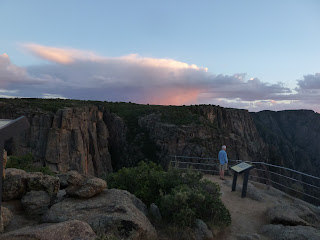We have had a pretty good trip without problems until today. Or last night really when we first had hail and then rain and more rain. We were staying in a campground that was flooded out by the Platte River a few years ago so it wasn't too relaxing to hear so much rain.
 This morning there were puddles everywhere, but the river did not rise into the campground. We had a long drive ahead of us so we were trying to get going early. While Rick took his shower I went out to start the car. We flat tow the car and have to start it every morning and run through the gears, then leave it to run in neutral for three minutes before towing it. This is usually my job. I turned the key and nothing happened. I checked everything and tried again. Nothing. Hmmm. Our first year of towing we had a problem with the battery running down as we towed because we have an axillary brake in the car which is tied to the brake system of the RV. When you press down the brake pedal in the RV, the brake pedal in the car also engages. It is a good safety system. But the brake system draws power. Everything in the car has to be switched off - lights, air, radio etc. or the battery dies. Rick installed a system that runs power from the RV back to the brake system so it doesn't run off the battery and we haven't had a problem with the car going dead since. Until today.
This morning there were puddles everywhere, but the river did not rise into the campground. We had a long drive ahead of us so we were trying to get going early. While Rick took his shower I went out to start the car. We flat tow the car and have to start it every morning and run through the gears, then leave it to run in neutral for three minutes before towing it. This is usually my job. I turned the key and nothing happened. I checked everything and tried again. Nothing. Hmmm. Our first year of towing we had a problem with the battery running down as we towed because we have an axillary brake in the car which is tied to the brake system of the RV. When you press down the brake pedal in the RV, the brake pedal in the car also engages. It is a good safety system. But the brake system draws power. Everything in the car has to be switched off - lights, air, radio etc. or the battery dies. Rick installed a system that runs power from the RV back to the brake system so it doesn't run off the battery and we haven't had a problem with the car going dead since. Until today.Rick checked and discovered a short in the system. He didn't have the tiny screwdrivers that he needed to fix it so I got him my eyeglass screwdriver. He very carefully worked on the wiring and taped over the shorts. But it isn't really fixed. We managed to recharge the car battery and made it all day on the battery. we recharged the battery again after we stopped today and will limp home with it tomorrow. Then back to the shop to see what can be done to ensure that the system can be relied on. Always something.
On our last night of camping we are just outside Des Moines in farm country. There is a great breeze without the smell of hogs. But there are more storm and flood warnings so we are prepared for anything. I am just trying to savor one last night on the road.



























